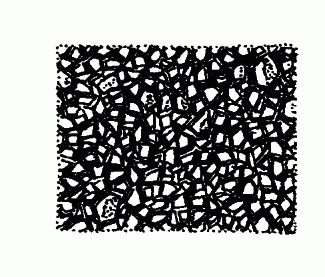Dermatocarpon reticulatum Magnusson
Sandpaper stippleback
Verrucariaceae
Introduction to the Lichens
Sandpaper stippleback
Verrucariaceae
Introduction to the Lichens
Map
Distribution of Dermatocarpon reticulatum unavailable
Species Information
General:
Common Name: The Stippleback Lichens. Emphasizes the presence of numerous dot-like perithecia over the upper surface.
Small to medium stratified foliose lichens, corticate above and below, lacking isidia and soredia, lobes attached to substrate by more or less central holdfast (except occasionally unattached in some species), loosely attached, subrotund to rotund, entire thallus averaging to 1–3 (–6) cm across, usually somewhat thick. Upper surface greyish to dark olive brownish. Lower surface pale brown or blackening, rhizinate or more often lacking rhizines. Medulla white. Photobiont green.
Ascocarp a perithecium immersed in upper surface, appearing as blackish dot from above; spores simple, ellipsoid, colourless, 8 per ascus.
Over rock, rarely over exposed soil.
As adopted here, Dermatocarpon includes all foliose or squamulose peritheciate lichens having simple spores and attached to substrate by one or more thickened holdfasts, whether central or marginal. Squamulose specimens attached by rhizoidal threads are treated under Catapyrenium.
Notes: Dermatocarpon is a cosmopolitan genus of approximately 60 species. Only seven species are reported for North America and five occur in B.C. This is a taxonomically difficult group in which many species appear to intergrade. The keys should be considered preliminary, pending a thorough taxonomic revision of the genus. Chemistry is of no diagnostic value in Dermatocarpon and has therefore been omitted in the following species accounts.
Species description:
Thallus lobes averaging to more than 6 mm across, or if smaller, then upper surface greyish and strongly white-pruinose; upper surface KC-; spores at most 8 per ascus AND
Rhizines absent AND
Upper surface white-pruinose; lower surface minutely textured/papillose, individual papillae cylindrical to more often pyramid-shaped, less than 0.1 mm across
Comments:
In exposed inland sites, this species may adopt an unattached/vagant habit and is then sometimes treated as a separate species, D. vagans Imsh.
Source: Lichens of British Columbia
Illustration

If more than one illustration is available for a species (e.g., separate illustrations were provided for two subspecies) then links to the separate images will be provided below. Note that individual subspecies or varietal illustrations are not always available.
Illustration By: Trevor Goward
Habitat and Range
Habitat: Frequent over rock in open or somewhat sheltered maritime and intermontane sitesWorld Distribution: western N Am, N to AK, S to NM.
Source: Lichens of British Columbia
Status Information
Synonyms
Synonyms and Alternate Names:
Dermatocarpon vagans Imshaug